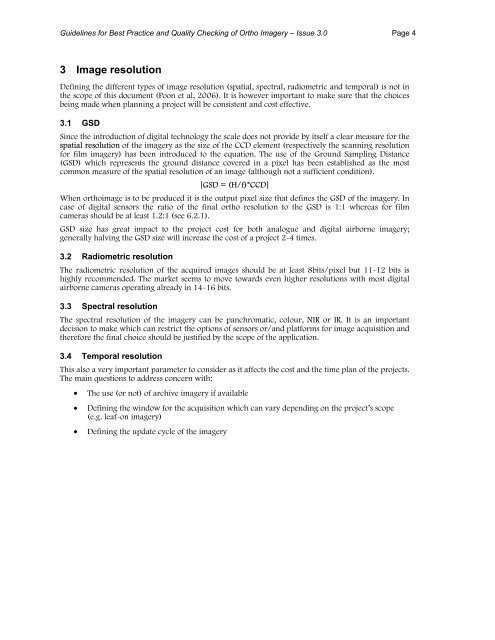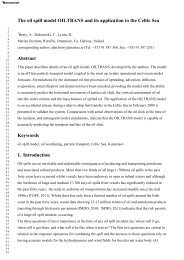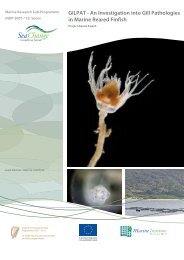Guidelines for Best Practice and Quality Checking of Ortho Imagery
Guidelines for Best Practice and Quality Checking of Ortho Imagery
Guidelines for Best Practice and Quality Checking of Ortho Imagery
You also want an ePaper? Increase the reach of your titles
YUMPU automatically turns print PDFs into web optimized ePapers that Google loves.
<strong>Guidelines</strong> <strong>for</strong> <strong>Best</strong> <strong>Practice</strong> <strong>and</strong> <strong>Quality</strong> <strong>Checking</strong> <strong>of</strong> <strong>Ortho</strong> <strong>Imagery</strong> – Issue 3.0 Page 43 Image resolutionDefining the different types <strong>of</strong> image resolution (spatial, spectral, radiometric <strong>and</strong> temporal) is not inthe scope <strong>of</strong> this document (Poon et al, 2006). It is however important to make sure that the choicesbeing made when planning a project will be consistent <strong>and</strong> cost effective.3.1 GSDSince the introduction <strong>of</strong> digital technology the scale does not provide by itself a clear measure <strong>for</strong> thespatial resolution <strong>of</strong> the imagery as the size <strong>of</strong> the CCD element (respectively the scanning resolution<strong>for</strong> film imagery) has been introduced to the equation. The use <strong>of</strong> the Ground Sampling Distance(GSD) which represents the ground distance covered in a pixel has been established as the mostcommon measure <strong>of</strong> the spatial resolution <strong>of</strong> an image (although not a sufficient condition).[GSD = (H/f)*CCD]When orthoimage is to be produced it is the output pixel size that defines the GSD <strong>of</strong> the imagery. Incase <strong>of</strong> digital sensors the ratio <strong>of</strong> the final ortho resolution to the GSD is 1:1 whereas <strong>for</strong> filmcameras should be at least 1.2:1 (see 6.2.1).GSD size has great impact to the project cost <strong>for</strong> both analogue <strong>and</strong> digital airborne imagery;generally halving the GSD size will increase the cost <strong>of</strong> a project 2-4 times.3.2 Radiometric resolutionThe radiometric resolution <strong>of</strong> the acquired images should be at least 8bits/pixel but 11-12 bits ishighly recommended. The market seems to move towards even higher resolutions with most digitalairborne cameras operating already in 14-16 bits.3.3 Spectral resolutionThe spectral resolution <strong>of</strong> the imagery can be panchromatic, colour, NIR or IR. It is an importantdecision to make which can restrict the options <strong>of</strong> sensors or/<strong>and</strong> plat<strong>for</strong>ms <strong>for</strong> image acquisition <strong>and</strong>there<strong>for</strong>e the final choice should be justified by the scope <strong>of</strong> the application.3.4 Temporal resolutionThis also a very important parameter to consider as it affects the cost <strong>and</strong> the time plan <strong>of</strong> the projects.The main questions to address concern with:• The use (or not) <strong>of</strong> archive imagery if available• Defining the window <strong>for</strong> the acquisition which can vary depending on the project’s scope(e.g. leaf-on imagery)• Defining the update cycle <strong>of</strong> the imagery
















